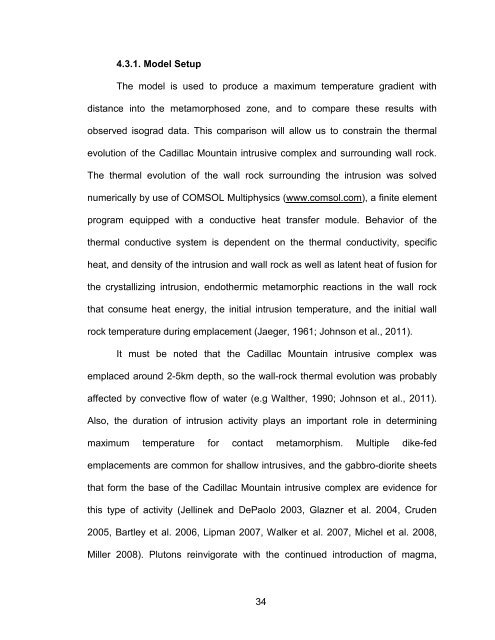Create successful ePaper yourself
Turn your PDF publications into a flip-book with our unique Google optimized e-Paper software.
4.3.1. Model Setup<br />
The model is used to produce a maximum temperature gradient with<br />
distance into the metamorphosed zone, and to compare these results with<br />
observed isograd data. This comparison will allow us to constrain the thermal<br />
evolution <strong>of</strong> the Cadillac Mountain intrusive complex and surrounding wall rock.<br />
The thermal evolution <strong>of</strong> the wall rock surrounding the intrusion was solved<br />
numerically by use <strong>of</strong> COMSOL Multiphysics (www.co<strong>ms</strong>ol.com), a finite element<br />
program equipped with a conductive heat transfer module. Behavior <strong>of</strong> the<br />
thermal conductive system is dependent on the thermal conductivity, specific<br />
heat, and density <strong>of</strong> the intrusion and wall rock as well as latent heat <strong>of</strong> fusion for<br />
the crystallizing intrusion, endothermic metamorphic reactions in the wall rock<br />
that consume heat energy, the initial intrusion temperature, and the initial wall<br />
rock temperature during emplacement (Jaeger, 1961; Johnson et al., 2011).<br />
It must be noted that the Cadillac Mountain intrusive complex was<br />
emplaced around 2-5km depth, so the wall-rock thermal evolution was probably<br />
affected by convective flow <strong>of</strong> water (e.g Walther, 1990; Johnson et al., 2011).<br />
Also, the duration <strong>of</strong> intrusion activity plays an important role in determining<br />
maximum temperature for contact metamorphism. Multiple dike-fed<br />
emplacements are common for shallow intrusives, and the gabbro-diorite sheets<br />
that form the base <strong>of</strong> the Cadillac Mountain intrusive complex are evidence for<br />
this type <strong>of</strong> activity (Jellinek and DePaolo 2003, Glazner et al. 2004, Cruden<br />
2005, Bartley et al. 2006, Lipman 2007, Walker et al. 2007, Michel et al. 2008,<br />
Miller 2008). Plutons reinvigorate with the continued introduction <strong>of</strong> magma,<br />
34
















